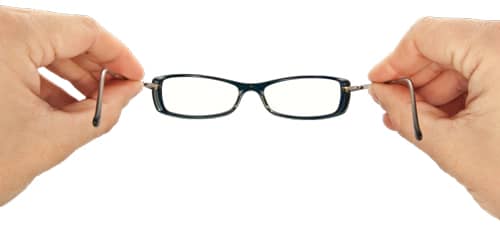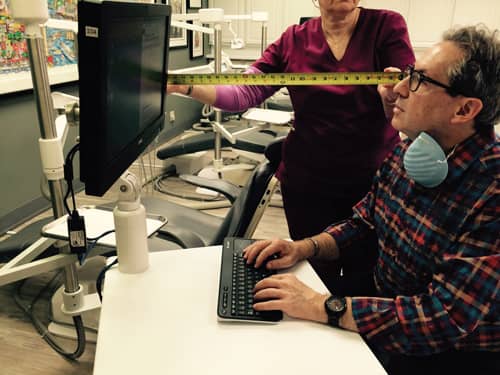Orthodontists present a unique set of issues when it comes to properly being able to visualize the “world” we live in. During a typical workday, we face a series of micro and macro visual challenges. We have to be able to see small markings on small brackets. We have to see the intraoral cavity so that we can properly treat our patients. We have to enter information at chairside computers. And we have to properly navigate the general office environment. These tasks can sequence from one to another rather quickly, and in no particular order, especially during after-school hours. While some practitioners may use loops to bond brackets, you can’t use those loops to write notes in the computer and greet patients in the waiting room.
How do you achieve visualizing a large area of focus? For those of you who don’t typically use corrective eyewear, you have no issues. It’s those of us who use prescription glasses who have the most challenges, which potentially worsen with age. It is not unusual for people in middle age to require corrective lenses, known as progressive lenses. These are lenses that typically correct for distance on the top part of the lens, and then progressively change in power toward the bottom of the lens to aid in near vision. The middle portion of the lens is typically designed to function somewhere in between near and distance, such as working on a computer, known as intermediate vision.
The problem is that the progressive lenses we use every day may not be usable in the office. For example, the near vision correction that we use to read the newspaper may not be adequate to see the small markings on a bracket. The middle or distance correction of the lens may not be properly calibrated to write chairside notes in the computer. So there may come a time when you need corrective lenses that you wear ONLY at the office because they are specifically designed to work within what we should call the “orthodontic area of focus.”
So how do you communicate this need to your eye-care professional? If they don’t know how you work, they may not be able to adequately correct for the orthodontic area of focus. So here are some tips to help you communicate these needs to your eye doctor, whom I will define as an optometrist or ophthalmologist who writes the prescription for the lenses. The optician is the person who measures you for the lenses and ultimately fabricates them, and who can help in the final design of the lenses by communicating to the eye doctor your specific needs. A word of caution here; this is sophisticated, customized eyewear. You need eye-care professionals with knowledge and experience, which you may not necessarily find at big box stores with hourly employees.
First, when going to your appointment with your eye-care professional, bring some brackets with you. Introduce them to our world. You may be surprised to find that eye doctors have absolutely no idea how small brackets are, and that they have small markings on them, and that you are expected to be able to see those markings. Once they know, they will be much better equipped to compensate for the bracket size when they design a prescription for your corrective lenses.
Second, have a staff member help you with some measurements. Using a tape measure, determine the distance from your eyes to the patient as you typically work chairside (Figure 1). Have this measurement done several times to accommodate different ages and sizes of patients, and take an average. Your eye-care professional may think you work 12 inches from the patient, for example. But if you work 9 inches from the patient or 15 inches from the patient, your corrective lenses may not work properly.
Third, have a staff member measure the distance from your eyes to your chairside computer as you write clinical notes (Figure 2). Again, your eye-care professional will be better equipped to design lenses for you if they know you work 24 inches from the screen, for example. In addition, have an assistant take a photo of you looking at your computer screen, and make note of your head position. How you hold your head and the height of your screen will affect the strength of your lenses.
I have used the word design a number of times now because it is realistic. Our needs are specific. What the eye doctor may perceive to be adequate for you may change drastically if they are aware of specific distances that are required. In addition, if you recall the way progressive lenses are typically fabricated, the distance prescription changes to the near vision prescription in a gradual fashion. This can be customized to your specific needs. Sophisticated design is possible if the parameters are understood.
The bottom line is that if you present for an eye-care visit with brackets, measurements, and photographs reflective of your requisite orthodontic needs, you can give your eye-care professional a huge amount of information to help design your particular lenses. These lenses will NOT work outside the office, and can be expensive. However, we have to be able to adequately see when we work, and we need our eyes protected from debris that we are bombarded with throughout our day. It’s worth the additional expense to have custom-made eyewear that can enhance your workflow. OP














